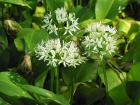Educational Centre with Museum » Permanent exhibitions
Permanent exhibitions
In the Educational Centre with Museum of the Magura National Park in Krempna one may visit the main exhibition and a few smaller temporary exhibitions.
In the exhibition hall a 30-minute show about nature is being presented. At first a visitor will watch a short film about the history of landscape shaping – from the development of the ground deposits on the sea bed, through the period of the stormy geological processes, the encroaching of plants and animals, right up to present times. Next scenes are nowadays – four large display cases built up as to show one year of the life of nature presented in four seasons and in four different habitats. In each of these places you will spend one day – from dawn to dusk.
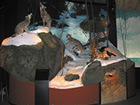 We begin in the early spring; wolfs’ howling, moonlight and ice melting are the first moments presenting the nature of the Magura National Park. A Carpathian sycamore forest which is being shown in this part of the exhibition creates a background for predators such as Lynx, Badger and Ravens.
We begin in the early spring; wolfs’ howling, moonlight and ice melting are the first moments presenting the nature of the Magura National Park. A Carpathian sycamore forest which is being shown in this part of the exhibition creates a background for predators such as Lynx, Badger and Ravens.
The next part of the exhibition brings a visitor into a warm and full of birds’ trills spring and early summer. Several plant communities are presented here - swamp alder wood, moist meadow Cirsietum rivularis and meadow Gladiolo – Agrostietum. Wild Boars and Beavers are also very attractive as well as the colorful meadows with many different species of blooming plants.
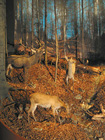 The third part presents late summer. On the dry meadow’s bank Roe Deer are feeding, Common Northern Viper is resting on the tree chunk and in high grass Short-tail Weasel is standing on his paws looking for food. In the distance we can hear a Buzzard which sits on the nearby cross.
The third part presents late summer. On the dry meadow’s bank Roe Deer are feeding, Common Northern Viper is resting on the tree chunk and in high grass Short-tail Weasel is standing on his paws looking for food. In the distance we can hear a Buzzard which sits on the nearby cross.
Autumn in MNP is presented on the fourth part of the exhibition. Loud voices of stags can be heard across the Carpathian beechwood. The rut - a mating season for Red Deer, has just began. Nearby, on the stream a yellow-necked mouse is looking for food. After nightfall, in the moonlight, Ural owl hooting informs other males about its territory.
After the show visitors may expand their knowledge about nature using the information contained in four infokiosks. They contain general information about the Park, photos, films and maps. You can also check your knowledge about nature using our tests.
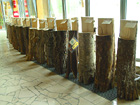 In the corridors an exhibition of tree trunks may be seen. 25 tree species occurring in this area are presented and they are put in order from the most common to the less common. That is way at the beginning you would find Beech, then Pine and Fir. There is a chart attached to every trunk that shows leaves, fruits and shape of each tree. Moreover, there is a plate with a name of a tree written in the Braille alphabet for the blind.
In the corridors an exhibition of tree trunks may be seen. 25 tree species occurring in this area are presented and they are put in order from the most common to the less common. That is way at the beginning you would find Beech, then Pine and Fir. There is a chart attached to every trunk that shows leaves, fruits and shape of each tree. Moreover, there is a plate with a name of a tree written in the Braille alphabet for the blind.
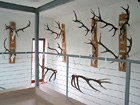 On the second floor there is an exhibition of deer antlers and skulls of animals living in the area of the Park. Antlers are presented in order according to the age of each animal so that every visitor would observe how antlers grow and take shape while deer grow old.
On the second floor there is an exhibition of deer antlers and skulls of animals living in the area of the Park. Antlers are presented in order according to the age of each animal so that every visitor would observe how antlers grow and take shape while deer grow old.


